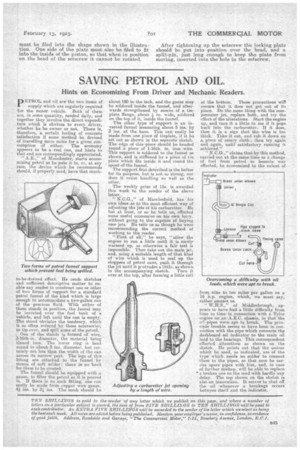SAVING PETROL AND -OIL.
Page 31

If you've noticed an error in this article please click here to report it so we can fix it.
Hints on Economizing From Driver and Mechanic Readers.
PETROL and oil are the two items supply which are regularly required
for the motor vehicle. Both of them are, in some quantity, needed daily, and together they involve the direct expenditure which is obvious to every driver, whether he he, owner or not. There is, therefore, a. certain feeling of concrete satisfaction if some method be devised of travelling more miles for a given consumption of either. The economy appears to be a real one, and hints to that end are correspondingly appreciated. " A.E.," of Manchester, starts economizing petrol as he puts it in, or, at any rate, the device which he recommends Should, if properly used, have that much to-Le-desired effect. He rends sketches and sufficient descriptive matter to enable any reader to construct one or other of two forms of support for a standard petrol funnel of the kind which is large enough to aecommodate a two-gallon can of the precious fluid. With either of these stands in position, the funnel may be inverted over the fuel tank of a vehicle, and left until the can is empty'. The stand obviates the tendency, which is so often evinced by these accessories, to tip ever, and spill some of the petrol. One of the stands is formed of wire, 3.16th-in, diameter, the material being tinned iron. The lower ring is bent round to about 8 ins, diameter, but certainly not less than the width of the can across its narrow part. The legs of this fitting are attached to the funnel by means of soft solder : there isno heed. for them to be riveted.
The funnel should be equipped with a gauze, to filter the petrol as it is poured in. If there is no such fitting, one can easily he made from copper wire gauze, 44. ins. by 3e ins. The mesh should be about 180 to the inch, and the gauze may he soldered inside the funnel, and afterwards strengthened by means of a ticplate flange, about in. wide., soldered on the top of it, inside the funnel.
The other type of support is an inverted funnel measuring about 5 ins. by 3 ins, at the base. This can easily be made from one piece of tinplate, if it be set out as Shown in the separate sketch. The edge of this piece should be beaded round a piece of 1-16th. in. iron .wire. This support is soldered to the funnel as shown, and is stiffened by a piece of tin plate which fits inside it -and round the spout of the funnel. . The support first described is the better for its purpose, but is not so strong, nor does it resist handling so well as the other.
The weekly prize of 15s. is awarded this week to the sender of the above letter..
of Macclesfield, has his own ideas as to the most efficient way of adjusting the jets of his carburetter. He has at least, or so he tells us, effected some useful economies on his own lorry, without going to the expense of buying new jets. He tells us as though he were recommending the correct method of working to the reader.
"First of all," he says, "allow the engine to run a little until it is nicely warmed up, as otherwise a fair test is impossible. Then take out the main jet, and, using a suitable length of that kind of wire which is used to seal up the stoppers of petrol cans, push it through the jet until it protrudes a little, as shown in the accompanying sketch. Turn it over at the top, after forming a little coil
at the bottom. These precautions will ensure that it does not get out of its place. Do the same thing with the compensator jet, replace both, and try the effect of the alterations. Start the engine up, and race it a little to see if it pops back into the carburetter. If it does, then it is a sign that the wire is too thick. Take it out, and rub it down on a piece of emery cloth; then try again and again, until satisfactory running is achieved."
" N.C.G.," claims that by this method, carried out at the same time as a change of fuel from petrol to benzole was effected, he economized to the extent of
from nine to ten miles per gallon on a 16 h.p. engine, which, we must say, rather amazes us.
" W.H.S.," of Middlesbrough, appears to have had a little difficulty from time to time in connection with a Tyler engine on an-A.E.C, chassis, in that the oil pipes were apt to break. The principle trouble seems to have been in connection' with the pipe which connects the dashboard oil indicator to the main oil lead to the bearings. This correspondent effected alterations as shown on the sketch. He points out that the unione which he used, as indicated, are of the type which needs no solder to connect them to the 'pipes, so that .now he carries spare pipes with him, and, in case of further mishap, will be able to replace • a broken one on the road with hardly any delay. The tap shown on the sketch is also an innovation. It serves to shut off, the oil whenever a breakage occurs' between itself and the indicator.
































